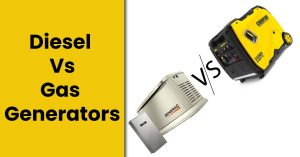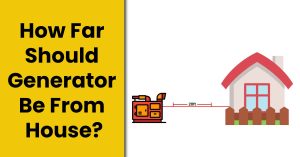How To Polarize A Generator In Right Way?
Polarization is a process that matches with the polarity for a generator as well as the voltage regulator to permit a surge of current flow through the generator by polarizing it in the right way. Polarization is very important because if the polarities do not match, massive damage can occur to electrical components.
Such polarization of a generator should take place when the following events occur:
- If the battery is disconnected or replaced from the tractor.
- If the generator is replaced or serviced.
- Or if the regulator is serviced or replaced.
Undoubtedly, it is essential to polarize a generator whenever you move or reinstall it to make it work in a proper way. This will help your generator to get the direct flow of energy in the right direction and this can be possibly done by 14- or 16-gauge wire. It doesn’t matter for which purpose you are trying to do it but you can keep up for electrical safety, removing the fan belt and using the proper gauge wire.
In this article, you will explore in detail how to polarize a generator. So, let’s start it.
How to Polarize A Generator

Whenever you remove a generator from an electrical system, it always needs to be polarized before reinstallation. By this process, you will be able to match the current flow to the electrical system before making any connection to the generator. The current produced by a generator can be either positive or negative but most of the electrical systems are specifically designed to accept a one-direction flow of current.
If you are using your generator on the regular basis, it will remember the particular direction by using stored magnetism. In case your generator isn’t used for a long period, the magnetism will ultimately dissipate. The generator will not remember the direction of the current flow.
A similar thing happens whenever a generator will be removed or replaced from its electrical system. So, it is vital to polarize a generator accurately before reconnecting it.
If you are not sure about the polarity of your system, you can take help from the manual provided by the owner or also ask for guidance from the manufacturer before initiating the procedure.
Tools That You Will Need:
There are some simple tools you will need for this process, such as:
- An insulated screwdriver or socket set
- 2 Alligator clips
- Jumper wire, 14 or 16 gauge
- Electrical tape
In case you are sure about the usage of proper tools, you will definitely save additional trips to the stores or unnecessary frustration.
Polarizing A 12v Generator:
A 12V generator can be installed in either a negative or positive ground system. That’s why it is important to know the polarity of your electrical system.
There are three steps discussed below that are compatible with all types of systems. While step four is more compatible with the positive and negative ground system.
Remove the Fan Belt: If your generator is still placed in the machine, it is a part of, you may need to remove the fan belt. You can remove it by using your hands or you can use a socket set or screwdriver to make the sway arm lose while holding the fan belt in place.
Adjust the fan belt, bolts as well as screws to the side to ensure you can keep the track of them easily.
In the market, magnetic wrist bands are available for individuals who often work with small accessories including screws and nails. These gadgets will stick to the wrist band and then you will see your life getting better and easier.
Fashion A Wire: With the help of 14- or 16-gauge jumper wire and two alligator clips, fasten a wire that is long enough to reach from the generator to the battery easily. This thing can prove a bit situational in length. But try to be a bit confident that there is no part of the wire that is exposed while using this electrical tape.
If any part of the wire is exposed, it can lead to electrical shock or even possibly can start a fire. So, make sure to take enough time to cover every inch of the wire with the help of electrical tape.
Attach the Jumper Wire: There should be a label ‘A’ on the terminal of your generator. This A usually stands for Armature terminal and it is a place where you might want to bind the jumper wire.
Negative Ground Systems:
Note: Make sure to have knowledge about the polarity of your system before heading to further procedures.
- Lightly rush the positive terminal on the battery by using one end of the wire.
- A few sparks will produce while doing so but be careful and do not keep the contact for too long as it will damage your generator ultimately.
- The stored magnetism will be restored inside the generator which will allow the right polarity of current to flow after turning on the power.
Positive Ground Systems:
Now, use the other end of the wire to brush it with the negative terminal of the battery.
It will also create a few sparks but again do not allow to keep that contact for a long time to avoid any damage to your generator.
In a similar way, magnetism will be restored and current with the right polarity will start flowing with power on.
Process of Polarization:
As discussed above, polarization is a procedure of matching the polarity of a generator to the voltage regulator.
When voltage is produced by a generator, the pole pieces start storing magnetism by indicating the direction of current flow.
Polarization is the process of matching the polarity of your generator to that of your voltage regulator. Substantially, the memory will be sufficient enough to keep or remember the voltage regulator and generator functioning accurately.
In case your generator is replaced or removed, the stored magnetism will also remove from its memory to decide about the direction of the current flow. In many electrical systems, there is a specific design that allows only to accept the flow of current in just one direction. If the direction is reversed, then the results will be catastrophic.
Severe damage will occur to the entire electrical system that will also disrupt the vital components permanently.
Why Is It Important To Polarize A Generator?
The generator is a device that plays a role in converting mechanical energy into electrical power for use. A generator can output either a negative or positive current.
When a generator is turned off, a few of its electrical current is retained in the form of stored magnetism. Whenever you start it next time, it will use that stored magnetism to restore the direction of flow of current in which it was flowing before.
If somehow, the stored magnetic force dissipates, the generator will become nonfunctional and won’t be able to produce any electricity. Not only this, if there is a reverse in the direction of magnetism or flow of current, it will also damage the other important parts of the machine.
One of such vital component is the voltage regulator. If before making connections, its polarization isn’t done properly then irreversible damage will occur to the entire system.
What Happens When You Don’t Polarize Your Generator?
Magnetism is usually stored in the pole pieces of a generator. The stored magnetism makes it easier to remind the generator about the direction of the current flow. Sometimes, even residual magnetism proves sufficient to allow a generator to function in an adequate way.
If your generator is serviced or removed from its previous place, it will ultimately increase the chance to dissipate the stored magnetism. So, it is very important to always polarize a generator before introducing it to an electrical system.
The polarity of a generator can also be reversed while it is still being serviced. If it is ever reintroduced into the electrical system, it can lead to extreme damage. The damage will be to both systems, one that is being connected and anything plugged into that system.
When To Polarize A Generator
Polarization of a generator can be done any time when some maintenance is going on to the generator or electrical system. In addition to this, the process can also be done any time your generator sits idle for long periods such as months or years.
If your generator is left idle for months or even years, there is a possibility of it losing the stored magnetism that will make it incapable of generating electricity. The damage will not be of the same level as happens in the case of reversed current but still, there will be some issues that can only be fixed after polarization.
- Recommended Guide: How to make a generator through DIY methods?
Is It Okay Not To Polarize A Generator?
It’s not okay not to polarize a generator. If you don’t polarize your generator, there are several issues that can happen, and some of them are severe. The regular contacts will eventually burn, and the generator will get damaged. Additionally, the battery can become discharged or even blow up.
If you don’t want to suffer any battery damage or any other issue, then you should always polarize your generator without a second thought.
Conclusion
When you are done performing the polarization of your generator, the current will flow through the electrical system smoothly. If the flow of current is improper, it will
When you’ve finished the polarization procedure, the current will correctly flow through your electrical system. Improperly flowing current can cause all kinds of issues and can destroy your system. By properly polarizing the generator before connecting it to the electrical system, you can be sure that you’re not causing permanent damage.
If the polarity of your system is known, the process will become easier for you. There is no need for complex tools rather you can do it by your basic handyman in a safe way.
Once you know the polarity of your system, the process is simple. It doesn’t require complicated tools and can be done by your basic handyman safely. No doubt electrical systems can be complicated but you must know some basics of it before jumping into the procedure.

Josh is a highly skilled electrician with specialized expertise in the field of generators. With years of experience under his belt, he has established himself as an expert in all aspects of generators, ranging from installation and maintenance to troubleshooting and repairs. Josh’s in-depth knowledge of electrical systems and his commitment to staying updated with the latest industry advancements make him a reliable and sought-after professional.






